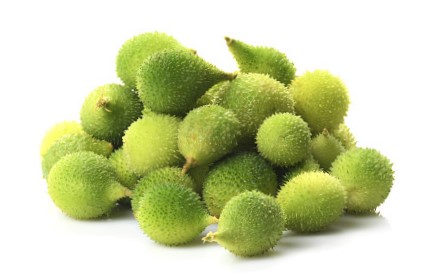

Momordica dioica Roxb. ex Willd.
|
Spiny gourd is commonly known as Kantola. It belongs to the family Cucurbitaceae. Its fruits are used as vegetable that has anti-allergic and anti-inflammatory properties. It is a vegetable which is low in calories. Consumption of the fresh juice of the spiny gourd helps in regulating blood pressure. M. dioica mediated gold nanoparticles exhibited promising anticancer properties against different human cancer cell lines HeLa, MCF-7, and A549 cells. Mode of Consumption : Boiled, fried |
| Plant Details | Agro-climatic Zone | Vernacular Names | Pictures |
| Scientific Name: Momordica dioica Roxb. ex Willd. Family: Cucurbitaceae Juss. Class: Magnoliopsida Order: Cucurbitales Genus: Momordica L. Fruiting Season: September-November Parts: Fruit |
|
Andhra Pradesh : Agakara, Karkotaki, A-kakara, Anga-kara-kaya Assam : Bhat-kerela Bihar : Kakora, Paroda, Kantola, Kheksi Chhattisgarh : Kheksi Goa : Phagil Gujarat : Katwal, Kantola Jharkhand : Kheksi Karnataka : Madahagala-Kaya, Madavaagal, Madihaagalu, Kaarchi, Kande Kerala : Venpaval Maharashtra : Kartoli Manipur : Karot Mizoram : Maitamtawk Odisha : Kankada Punjab : Bharkarela Rajasthan : Bara karela, Kankera, Kankoda Tamil Nadu : Paluppakkay, Mezhuku-pakal, Pazhu-pakal Uttar Pradesh : Parora, Kantola West Bengal : Ghee korola, Kankrol, Bhat korola |
 Fruits |
| Compound/Extract | Activity | Mode of Action | Marker/References |
| Momordica dioica mediated gold nanoparticles | Anticancer | Momordica dioica mediated gold nanoparticles exhibited promising anticancer properties against different human cancer cell lines HeLa, MCF-7, and A549. The down-regulation of Bcl-2, Caspase-3, and -9 activities revealed that the AuNPs induced caspase-dependent apoptotic cell death in HeLa cells. | Bcl-2, Caspase-3, and Caspase-9[2] |
| Male and female plant extract | Anticancer, Antioxidant | The male and female plant extracts showed inhibition on breast cancer (MCF-7) cell lines with IC50 values of 135.9 µg/ml and 86.56 µg/ml respectively. | [4] |
| Aqueous extract | Antidiabetic | Aqueous extract induced insulin secretion in Wistar rats. | [5] |
| Major Class | Metabolites (Content of bioactives: mg/100g Fresh Weight) |
| Alkaloid | Momordicin: [1] |
| Fatty acid | Stearic acid: [1] |
| Flavonoid | Catechin: , Quercetin: [3] |
| Glycoside | Cucurbitane: , Gypsogenin: [1] |
| Steroid | 3-O-β-D-glucopyranosyl gypsogenin: , 3-O-β-D-glucopyranosyl hederagenin: , 3-O-β-D-glucuronopyranosyl gypsogenin: , 3β-O-benzoyl-11-oxo-ursolic acid: , 3βO-benzoyl-6-oxo-ursolic acid: , α-Spinasterol-3-O-β-D-glucopyranoside: [3] |
| Terpene | Cucurbitacin S: , Hederagenin: , α-Spiranosterol hederagenin: [1] |
| Triterpene | Momordicaursenol: [1] |
| Triterpenoid | Oleanolic acid: [3] |
| Vitamin | Ascorbic acid: [1] |
| Effect | Observation | DOI |
| Disease | Formulation | Reference | Author | TKDL |
| Information from Wealth of India | Reference |
|
CSIR(1962).The Wealth of India, Raw materials,Vol.- VI ,P.411-412, New Delhi, India |
| 4.2, 4.2.1, 4.2.1.1, 4.2.1.2, 4.2.1.3, 4.2.2.2, 4.2.2.8 |
| CSIR-North East Institute of Science and Technology, Jorhat-6, Assam, India
CSIR-Institute of Himalayan Bioresource Technology, Palampur-61,Himachal Pradesh, India |